AM: Flight to Baltra Airport (GPS)
Upon arrival, Galápagos National Park staff will check your luggage to prevent the introduction of foreign species. You'll need to pay a $200 entrance fee. A naturalist guide will meet you and take you on an hour-long bus ride to the pier to board the Galapagos Sea Star Travel.
PM: Charles Darwin Research Station (Santa Cruz Island)
Visit the Charles Darwin Station to learn about its vital role in protecting and conserving the islands. You’ll see giant tortoises from islands like Santiago, Santa Cruz, Floreana, and Pinzón at the breeding center. After the tour, enjoy free time to explore town and shop for souvenirs.

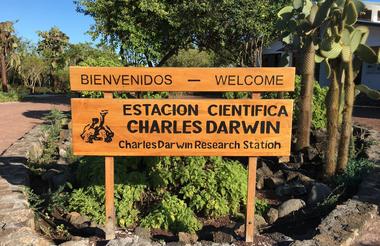

Lunch
Dinner
AM: White-Tipped Reef Shark Canal & Tintoreras (Isabela Island)
Take a boat ride to spot blue-footed boobies, pelicans, herons, and Galápagos penguins. After a dry landing, follow a loop trail on a volcanic islet where you'll see baby marine iguanas, lava lizards, sea lions, and yellow warblers. The canal, known as Tintoreras, is named after the white-tipped reef sharks that rest in its shallow waters.
Midday: Sierra Negra Volcano
From Puerto Villamil, take a bus to the slope of Sierra Negra, one of the largest volcanic calderas in the Galápagos. Hike along its rim to see stunning views of the collapsed and uplifted lava formations. Good hiking shoes and a light rain jacket are recommended.
PM: Wetlands & Tortoise Breeding Center (Isabela Island)
After a short bus ride from the jetty, visit the Jacinto Gordillo Breeding Center to see giant tortoises from different parts of Isabela at various life stages. Continue on foot through mangroves and wetlands where flamingos, herons, iguanas, and migratory birds are often seen. The trail ends at the beach, where you’ll have free time to relax or explore the nearby village.



Breakfast
Lunch
Dinner
AM: Punta Moreno (Isabela Island)
After a wet landing, hike across dramatic lava fields with both smooth pahoehoe and jagged aa lava flows—great for photography. Along the trail, you may spot flamingos and wading birds near hidden lagoons. Then, take a boat ride to observe the largest marine iguanas, Galápagos penguins, flightless cormorants, pelicans, and blue-footed boobies. You’ll also have a chance to snorkel in deep waters from the zodiac.
PM: Elizabeth Bay (Isabela Island)
Explore this quiet bay by paddle boat (no motors allowed), gliding through red mangroves where you can see spotted eagle rays, golden rays, sea turtles, and flightless cormorants. This is a known sea turtle mating area. Nearby, visit the Marielas Islets—home to the largest colony of Galápagos penguins, as well as marine iguanas, boobies, and pelicans.



Breakfast
Lunch
Dinner
AM: Punta Espinoza (Fernandina Island)
Visit one of the most untouched areas in the Galápagos. Due to volcanic uplift, former coral reefs and mangroves have been exposed, creating a dramatic landscape. Look for Galápagos hawks, lava lizards, marine iguanas, and flightless cormorants. Snorkel in the shallow waters where you may encounter sea turtles and marine iguanas feeding underwater—watch their unique swimming behavior using feet and tails.
PM: Tagus Cove (Isabela Island)
After a dry landing, climb a wooden staircase for panoramic views of lava fields and Darwin Lake. Learn about the site's history, including old sailor graffiti carved into the cliffs. On the return, enjoy a boat ride along the shoreline where you can see blue-footed boobies, flightless cormorants, and Galápagos penguins—the only tropical penguin species, with colonies on Isabela and Fernandina Islands.



Breakfast
Lunch
Dinner
AM: Espumilla Beach (Santiago Island)
Visit this golden-sand beach, a key nesting site for marine turtles. Watch ghost crabs scurry across the sand and take a short hike inland through arid terrain. Along the trail, you might see flamingos, pintail ducks, Galápagos hawks, mockingbirds, finches, yellow warblers, and doves. Optional snorkeling is available.
PM: Puerto Egas (Santiago Island)
Land on a black volcanic sand beach, a favorite resting spot for sea lions. Walk a loop trail through ash and rugged basalt rock. Along the coast, spot marine iguanas, Sally Lightfoot crabs, herons, warblers, finches, and migratory shorebirds. At the end, visit the grottos—home to Galápagos fur seals.
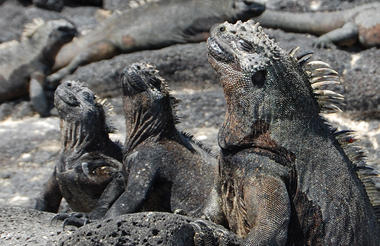
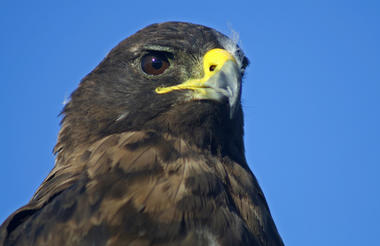
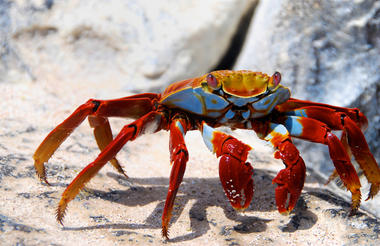
Breakfast
Lunch
Dinner
AM: Isla Lobos (San Cristóbal)
Start early with a visit to this small island near Puerto Baquerizo Moreno. You’ll be greeted by a large colony of Galápagos sea lions whose males’ barks fill the air. Walk a trail through semi-desert terrain where blue-footed boobies nest on the ground and frigatebirds perch in the trees. The vegetation includes black mangroves, saltbush, and holly stick. After the visit, you’ll be transferred to the airport for your flight back to Guayaquil or Quito.
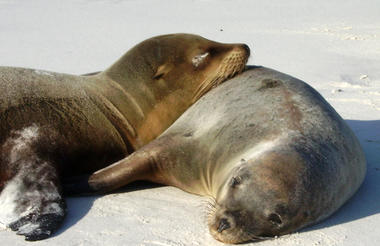

Breakfast







